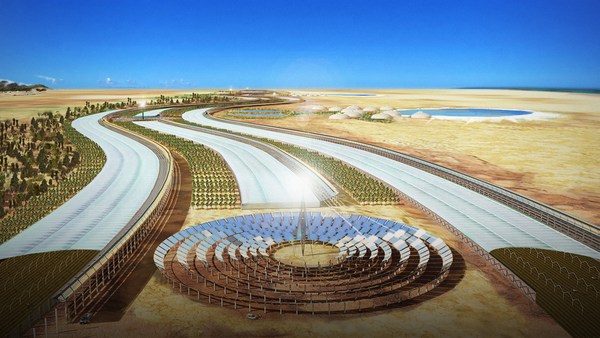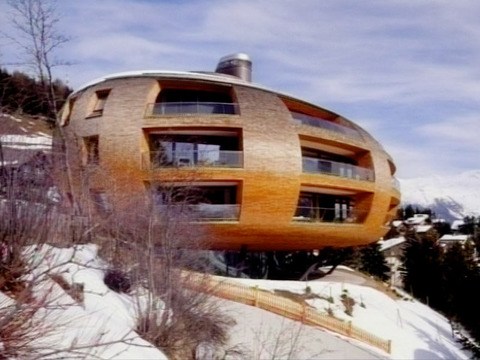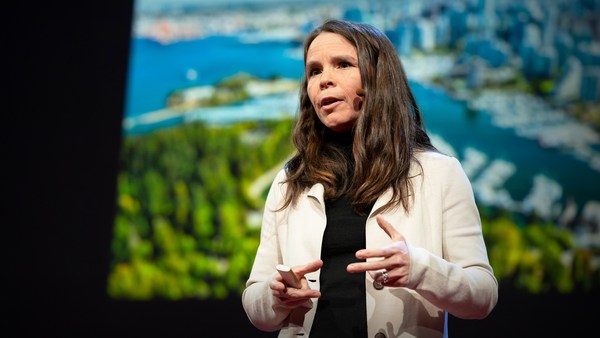I live in big, beautiful British Columbia, and my life is fueled by exploring nature both at home and around the world. In fact, this is from the Himalaya just a few months ago when I was climbing there. Nature is a huge part of my life and it inspires my creative and professional world as well. I work hard with my team inspired by nature in Vancouver, designing buildings.
As an architecture practice, we have two main missions. Our first mission is to focus on making beautiful buildings that serve our community and respond to the needs of the people within them. The second mission we have is focused on the fact that the first mission has a huge impact on the planet and on climate change, and we have to work to reduce it.
As a result, our firm is often called a highly sustainable practice, and the truth is, it really isn't. In fact, I don't believe that word "sustainable building" or "sustainable practice" is really true in most cases. And the reason is the built environment uses an enormous amount of the world's resources, and far too few of those come from renewable resources. In fact, the vast majority of the material that man makes on Earth goes into the built environment.
The other challenge with buildings is they represent about 39% of our greenhouse gas emissions, or, in North America, almost half of our greenhouse gas emissions. For reference, because it's not talked about enough, all of cars, planes, automobiles, the entire transportation sector combined represent only about 23%. So buildings are a huge part of the problem and not discussed enough.
The reason for that are both the heating and cooling of buildings, of course, but also the materials that go into buildings. And when it comes to materials, the buildings' structures, what holds the buildings up, really are composed of four major materials in every city on the planet: concrete, steel, masonry and wood. And of those four materials, three of them have very, very high carbon footprints, in particular concrete and steel.
Now, wood is the only material on that list that's also a renewable resource and sequesters carbon. So it's the only pathway as a material that actually can get us to carbon-neutral buildings. And it's the pathway we choose in our practice to build all buildings.
So our practice has been a timber-only practice since our inception and as part of our advocacy for the use of wood in buildings, about 15 years ago, I wrote a book called "The Case for Tall Wood Buildings," and that book taught the lesson of why we should do this and how we should do this. And in the beginning, it was a very unlikely concept that people had a hard time believing. And yes, we figured out that we could have built the Empire State Building entirely out of wood.
That early idea now is a mainstream concept around the world in sustainable building practices, and there are hundreds of tall wood buildings that have either been built or are currently under design and construction, and thousands more to come.
But wood as a sustainable idea is not sustainable unless it actually comes from sustainable forest practices. And much of the planet has forests that we actually need to keep standing as part of our climate solution. And in fact, lots of the world have forests that are under deep threat. If we think about where population in the world mostly resides and where it's growing the quickest, in fact, most of those areas either don't have forests or also are aware these forests are threatened.
And so wood, as good a solution as it is and a solution that I still very much believe in, is not a global solution. Most of our cities are still built in those first three materials: steel, concrete and masonry, and they have a high carbon footprint. We're working hard and people are working hard to make concrete and steel better. But unfortunately, tweaking those existing materials is making them only modestly better. In the case of concrete, it's estimated they can reduce the carbon footprint of concrete at best between 10% and 35%. And that's a long way to go from where we need to be, either at carbon neutrality in our cities, or better yet, in carbon-sequestering, carbon-negative buildings.
So how do we get there? After building about 1.5 million square feet of mass timber I still believe in that material, but I keep asking myself this question: what is the alternative to “the big four”? And the answer, in my mind without question, is studying and understanding what's happening in nature and nature's structures, combining that with modern biotechnology and combining that with all of the computer modeling that allows us to make incredibly efficient structures going forward. All those things together are creating what we call “Five.”
Five is a fifth way, a new structural material that will replace, in my mind over time, “the big four.” It's an all-organic material made from forests and crops that can be grown all over the world. It's strong and safe, and it eventually will be cost-effective and competitive against any other material available.
Now, this isn't a new idea. Products made from natural materials, thankfully, are growing up everywhere. There's a huge industry of biomaterials in academia, as well as in private business. And we're seeing new products come online every day. This community is strong and hopefully getting stronger and our contribution to it is really focused on this idea of the biggest material use, which again is the building structure.
So how does it work? So the idea is based on the same concept of how a tree works or any other vascular plant. As we zoom in, a tree is sort of made of lignified tissues that go from the bottom of the tree to the top, as are plants. And those lignified tissues have within them, in cell structure, cellulose fibers and lignin that together make the plant strong in order to grow and thrive. And those two materials, the fiber in the plant, as well as the lignin, as well as other binders, make up the ingredients of what we call Five.
Studying the fibers and how they work in plants is another part of how we're trying to make this structure. And if we all imagine cutting through a branch as the image just showed, we know that nature finds very efficient ways to create structures, and they're often round like a branch. But as humans, we tend to make boxy structures. And the reason we do that is concrete, steel and these materials and wood, are more efficient when we form them as a box or when we cut them as a box, It's more affordable and that's why we see it.
So a typical structure has columns and beams and a slab that make it up, and they're very boxy forms, as you can see in the image. Now different structures behave very differently all the time. This particular structure is an example from a tall building, but if we were talking about a house, it would be a different structure. Or if we're talking about a hockey rink, it would be another structure.
So just in this example, how do the forces work? Well, you have the force of the weight of people and you have the force of the weight of the building above. You have wind blowing on the sides or an earthquake impacting it. The forces, as they press down on this particular example, in blue are forces of compression. That’s the squeezing forces, pushing down. And the forces here in yellow are the tension forces, the pulling apart on that structure. When we put those together, we see how the forces move to the ground through this simple frame. And it's sort of a flowing diagram.
In fact, when we use what's called a structural stress plot, you can see that the form is very natural in its character. But as I said, we build things out of boxes, and when we overlap in our example, a boxy structure of wood, for example, we see these areas in red which really are unnecessary. There wasted material in the current way we build.
In this example, working with our engineers, we actually calculated that this particular example would result in about 27% material waste. Now all buildings are different. It's very hard to make a sort of overall calculation, some buildings are more efficient, some less efficient. But if we multiply this by the amount of building that needs to be built over the next 40 years for humanity, it's an incredible amount of human waste. And poor use of our resources.
So our goal with Five is how do we use as little resources as possible? And when you use little resources in a building, you lighten the building up, and a lighter building actually means that it weighs less on the ground, and our foundations below the ground can be lighter as well. So less resources equals lighter buildings equals even less resources.
Taking this idea of how Five can use less, we took four existing known solutions and put them together.
The first is we take those plant fibers I described and that can come from trees, that can come from plants, grass, bamboo. It can come from waste wood products. It can come from clearing the understory of a forest to make it less likely for forest fire in places like California. We take those fibers and combine them with other organic binders and lignin in order to sort of create a solid product.
And then we take these computer models that allow us to really design efficiency into the way we build so we can boil out all that waste.
And then finally, we're going to use custom robotics. That means that every part of a building, rather than being cookie cutter and the same and wasteful, could be just as much material as needed and no more in order to make the building safe.
Together, that makes something that looks like this. And again, this is an example. The flat top is flat because we walk on floors, but underneath the building looks more organic in its shape, and as you can see, these beams and columns feel a little bit more like branches and more like what we see in nature.
As we zoom in even further, we start to see how it's actually composed. And you may think in your mind: is this fiberboard? Is this particleboard, things you’ve seen before? Well, actually what we're talking about is a very microscopic layering of these plant fibers that are just a millimeter long. By laying them together and cross-laminating them across each other, we can customize the way, based again on a structural model, exactly how the composition of each piece of the material works in order to make it as efficient as possible. We combine it with these organic polymers and lignin and ultimately make this material as strong, dense, and it behaves much like a tree would.
Now we do that in another unique way in the way the forming works. Because no pieces of a structure have to be the same and we want to reduce waste, we use robotic forms and fabric forms. The red is fabric that moves in and out and allows each piece of the building to be completely, uniquely customizable. And again, we're using it to reduce the waste of the structure.
Now when we put that all together, it looks like something completely different, something that none of us have seen before. It's not like steel, it's not like concrete and it's not like wood. Instead, in this example, what you see is an entirely plant-based structure. It's healthy and beautiful to be around. Its shapes are not there as decoration. They're there as just structural essentials, and yet they're beautiful. It's safe to be within. It sequesters carbon, so it's part of our solution for climate change.
I believe we cannot continue to work with broken systems and try to make them better. We have to imagine something next. We also can't wait for the world's resources to run out before we imagine a future that's different. We are no longer part of an industrial revolution of materials. We are at the beginning of Mother Nature's revolution of materials. And as a result, we can make much more beautiful environments for everyone.
As I walk around the forest of my home and I look up into the trees and imagine what the buildings of the future are, I imagine that they'll use less resources, they'll have less impact. They will still make strong, healthy communities for all of us. But they'll do so more efficiently.
All of these ideas are ideas that already exist. There's nothing new here. We have an opportunity to live in a completely biological world. We just have to decide to do so.
There is a community growing of companies and products of biomaterials that are available, and every day there are new materials introduced into the system. We can and we will solve this combination of human need and the planet's need at the same time. All we need to do is listen to nature and let her teach us how.
Thank you.
(Applause)





